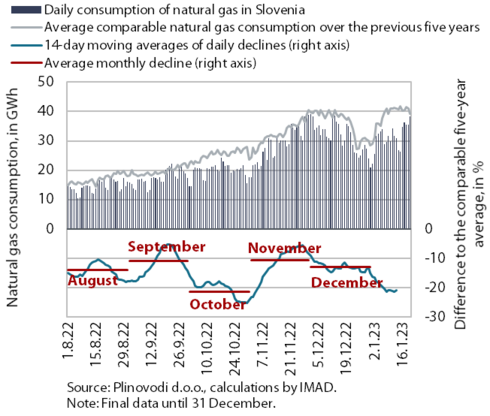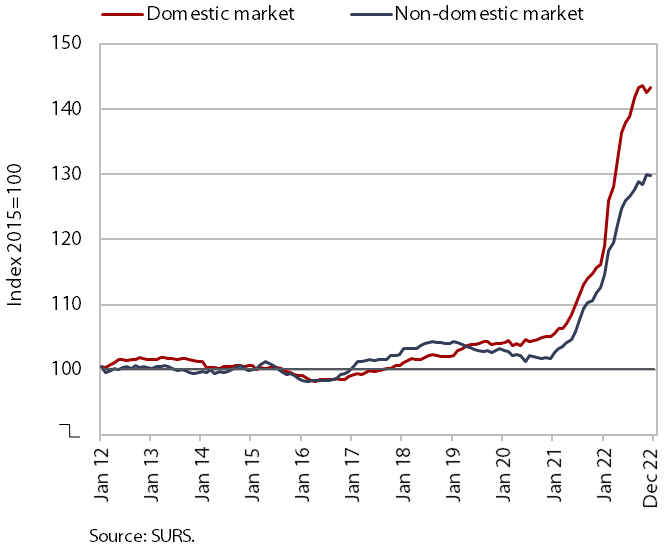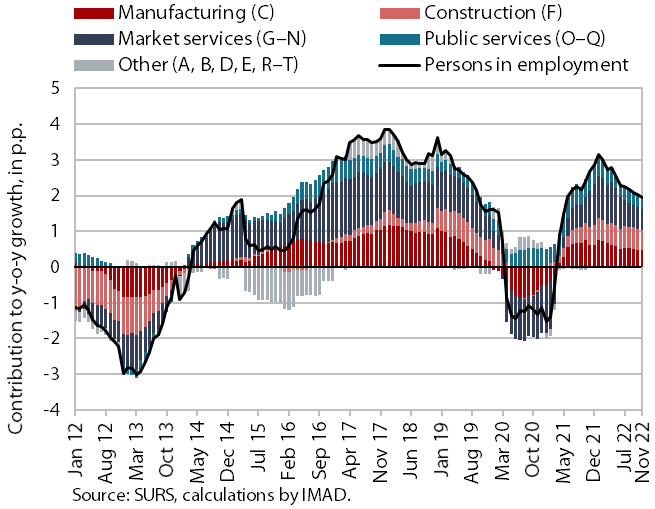Charts of the Week
Charts of the week from 16 to 20 January 2023: natural gas consumption, Slovenian industrial producer prices and number of persons in employment
In the last months of last year, natural gas consumption was about 12% lower than in the same period of previous years due to warmer weather and adjustments of production to high energy prices. At the beginning of this year, the drop in consumption was even more pronounced. According to Eurostat, EU Member States reduced their gas consumption more than Slovenia between August and November. The year-on-year growth in Slovenian producer prices slowed further in December but remains high. In November, year-on-year growth in the number of persons in employment slowed slightly but was still close to 2%. It was strongest in construction, which also faces significant labour shortages and has a high share of foreign workers among persons in employment.
Natural gas consumption, January 2023

In the last two months of 2022, natural gas consumption was 12% lower than in the same months of previous years and at the beginning of 2023, the drop in consumption was even more pronounced. Part of industry reacted to the high gas prices by reducing production output and thus consumption. Government measures also contributed to a more rational use of gas. According to Eurostat, EU Member States reduced their gas consumption more than Slovenia between August and November, by an average of 20% compared to previous years and Scandinavian and Baltic countries by more than 40%. By mid-November, EU Member States were able to assure that their gas storage capacities were almost full, but since then the storage level has been gradually declining. According to preliminary data, gas consumption in Slovenia from 1 August 2022 to 20 January 2023 was almost 15% lower than the comparable average consumption over the last five years, which is in line with the EU recommendations for gas consumption reduction in the August 2022 to March 2023 period.
Slovenian industrial producer prices, December 2022

The year-on-year growth of Slovenian industrial producer prices has gradually slowed, to 19.3% in December. Unlike in November, growth in foreign markets slowed (from 16.2% to 15.3%), while growth in the domestic market remained roughly unchanged (it increased from 23.2% to 23.3%). As economic activity weakens, price growth in the commodities group slowed further (19.4%), while growth in capital goods prices also declined slightly (10.2%). The increase in energy prices remained roughly unchanged (180%). The increase in consumer goods prices continued to strengthen (14.3%), especially of non-durable goods (15%), while price growth in durable goods weakened slightly (11.7%).
Number of persons in employment, November 2022

Year-on-year growth in the number of persons in employment was 1.9% in November, slightly lower than in previous months. It was strongest in construction, which is facing a major labour shortage. Employment of foreign workers contributed most to the overall growth in the number of persons in employment – its contribution was still 77% year-on-year in November. The share of foreigners in the total number of people in employment remained unchanged from the previous month (13.8%), while it increased by 1.3 p.p. year-on-year. Activities with the largest share of foreign workers are construction (47%), transportation and storage (32%) and administrative and support service activities (26%). In the first 11 months, the number of people in employment rose by an average of 2.5% year-on-year.
